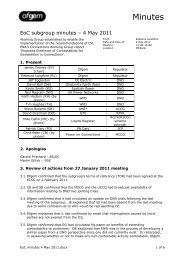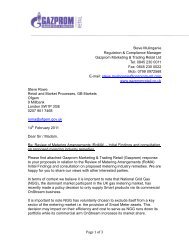RIIO-T1 and GD1: Draft licence conditions – First informal ... - Ofgem
RIIO-T1 and GD1: Draft licence conditions – First informal ... - Ofgem
RIIO-T1 and GD1: Draft licence conditions – First informal ... - Ofgem
You also want an ePaper? Increase the reach of your titles
YUMPU automatically turns print PDFs into web optimized ePapers that Google loves.
50<br />
<strong>RIIO</strong>-<strong>T1</strong> <strong>and</strong> <strong>GD1</strong>: <strong>Draft</strong> <strong>licence</strong> <strong>conditions</strong> <strong>–</strong> <strong>First</strong> <strong>informal</strong> <strong>licence</strong> drafting<br />
consultation<br />
with the <strong>conditions</strong> impacting allowed revenue through the annual<br />
iteration of the PCFM 70 <strong>and</strong> via the TOMOD term.<br />
(b) If entry or exit capacity is triggered, the revenue driver gives rise to<br />
additional allowed Totex expenditure <strong>–</strong> the PCFM variable value would<br />
be revised to reflect this<br />
(c) The additional allowed Totex would be modelled (including Totex<br />
Incentive Mechanism effects going forward) on the TO side <strong>and</strong> would<br />
adjust allowed revenue through the TOMOD term<br />
(d) Separately, the SO side of the business would charge the customers<br />
concerned in accordance with its current charging methodology <strong>–</strong><br />
meaning there would be no direct link between customers charges<br />
<strong>and</strong> allowed revenue on the TO side in any particular year in respect of<br />
these revenue drivers<br />
(e) NGGT would report the income under point d) as part of its actual TO<br />
income (rather than SO income as it does presently).<br />
� This preserves the existing charging structure whilst implementing the <strong>RIIO</strong><br />
approach.<br />
� We propose that permit provisions currently provided in C8D, 3(g) to (j) <strong>and</strong><br />
C8E, 5 are also treated under the TO revenue restriction rather than the SO<br />
(as at present) <strong>and</strong> will be part of a specific <strong>licence</strong> condition. In this case we<br />
propose that revenues would be recovered through TO rather than SO<br />
charges. See GTC 131:Delivery Incentive ,below for further details.<br />
� We propose that costs <strong>and</strong> revenues associated with Constrained LNG <strong>and</strong><br />
long-run contracting incentive, currently found in SpC C8E 1(c) <strong>and</strong> 1(e), will<br />
be captured through a new specific <strong>licence</strong> condition, see GTC132<br />
(Transmission Support Services). For the avoidance of doubt these revenues<br />
will continue to be funded through TO charges.<br />
3.38. Appendix 4 71 provides more detailed information on how the new proposed<br />
<strong>licence</strong> <strong>conditions</strong> are updating or replacing existing arrangements under the current<br />
condition.<br />
70<br />
For further details, please see chapter 6: The Annual Iteration Process for the Price Control Financial<br />
Model <strong>and</strong> updating of base revenue allowances<br />
71<br />
Appendix 4: Special Condition C8D: NTS gas entry incentives, costs <strong>and</strong> revenues <strong>and</strong> Special Condition<br />
C8E: NTS gas exit incentives, costs <strong>and</strong> revenues




